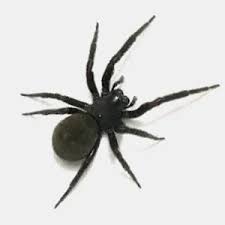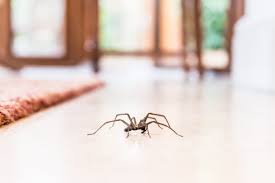The black house spider (Badumna insignis) is a common species found in Australia. They occur in most parts of the country, especially urban areas. They belong to the Desidae family of spiders as well as the Grey House Spider (Nadumnalonginquus).
Unless provoked, black house spiders are not aggressive towards humans. Their bites are not venomous, but they can cause pain and localised swelling. More serious symptoms include nausea, vomiting, sweating, and skin lesions.
How to Spot a Black House Spider
As their name implies, black house spiders have a dark colour. Their carapace and legs are dark brown to black, while their abdomen is charcoal grey with a dorsal pattern of white markings. Female black house spiders are typically larger than males. The average length of an adult body is 14 to 15mm.
Black house spiders are often mistaken for funnel-web spiders due to their similar web styles. But there is an easy way to tell the difference. The web of a funnel-web spider is often formed as a burrow in the ground. Meanwhile, the web of a black house spider is messy and has distinct triangular-like shapes, and the funnel serves as an entrance to the nest.
Habitats
Black house spiders prefer to live in areas with good shelter. In the home, this could be near window frames, under leaves, inside gutters, on brickwork, and around the rocks and bark. In the outback, this could be in rough-barked trees, as they provide great shelter for their retreats.
Grey House Spiders live in areas that are virtually identical to those of the Black House Spider.
Food and Diet
Black house spiders mostly feed on flying and crawling insects. These include flies, beetles, butterflies, bees, and ants. To catch these pests, they find refuge in trees that have been attacked by wood-boring pests. Why? Because the sap that flows from the bored holes attracts those very same pests.
Inside, black house spiders hunt for insects that are sensitive to light; in particular, those attracted to light from windows and lamps. To achieve this goal, they build webs in these areas.
Lifecycle and Breeding Behaviour
Males, when ready to mate, go out in search of females who are residing in their webs. The female spiders typically never leave their web unless forced to, and will continue to repair it, as is evident by the frayed, tattered appearance of their webs.
Once the male finds a suitable female to mate with, they will stay with the female for several days. The two may mate multiple times during this period. From there, the female builds several white silk egg sacs, and stays in the web with the sacs until they hatch.
Potential Danger to Humans
While black house spiders are usually not aggressive and their bites are not venomous, they can still cause pain and swelling. Patients can also experience nausea, vomiting, sweating, and – in the case of multiple bites – skin legions.
When giving medical assistance to a spider bite patient, use an ice pack to apply gentle pressure to the bite. Seek medical help if symptoms persist or get worse.
How to Remove and Prevent Black House Spiders
Apply over-the-counter spider surface spray to their webs and hiding places. The formula for these products is specially designed to give you a protective barrier of control for several months. Target specific areas like under eaves, around window frames, downpipes and guttering, and sheds.
If you already have live black house spiders on the premise, use direct bug spray to kill them on sight.
Unfortunately, even with the best intentions, a DIY spider control plan is never fool-proof. There may be hiding spots you are unaware of. The spiders may avoid the areas you target. And without regular monitoring they could return a short while later.
If you are experiencing a large, sudden onset of black house spiders, contact the experts at All Bugs.
Our licensed team will be happy to discuss your pest problem, arrange a site survey, and provide a quote and treatment plan. Plus they will visit you as much as necessary to ensure the problem is resolved. So you can rest easy knowing that your home and family is safe from the threat of spiders.
To request a free, no obligation quote for professional spider control, contact All Bugs today.




Leave a Reply